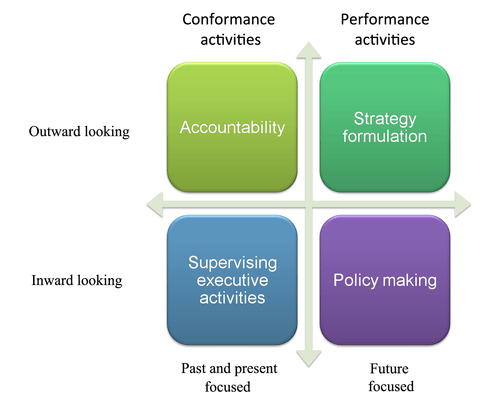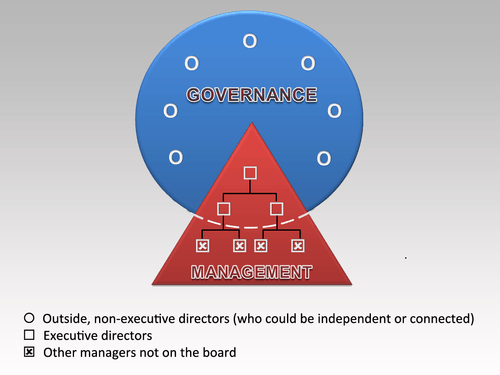Robert Ian Tricker
Bob Tricker is an expert in corporate governance who wrote the first book to use the title Corporate Governance in 1984,[1] based on his research at Nuffield College, Oxford. He was also the founder-editor of the research journal Corporate Governance - an international review (1993)[2] .
Biography
I have always regarded Bob Tricker as the Father of Corporate Governance since his 1984 book introduced me to the words corporate governance.[3]
- --Sir Adrian Cadbury,author of the first corporate governance code (UK, 1992)[4]
Leaving King Henry VIII Grammar School, Coventry at 16, qualifying as a chartered accountant at 21, serving as an officer in the Royal Navy, and being financial controller of a manufacturing company[5] are not the most obvious steps towards an academic career. But after studying at the Harvard Business School and Oxford University(P.D. Leake Research Fellow 1966/67), Bob Tricker became the first professor of management information systems at the University of Warwick (1967–1970).[6] He then returned to Oxford as Director of the Oxford Centre for Management Studies (1971–79) and to a Research Fellowship at Nuffield College, Oxford (1979–1984), where he undertook the research that led to Corporate Governance (1984).[7]
Bob Tricker was awarded a doctorate (D.Litt.) by the UK Council for National Academic Awards, and has served on the Councils of both the Institute of Chartered Accountants in England and Wales and the Institute of Chartered Management Accountants. In 1984 he set up the Hong Kong Management Development Centre, and was appointed Professor of Finance at the University of Hong Kong,[8] a post he held until 1996.[9]
Currently he is a member of the editorial board of Corporate Governance – an international Review,[10] one of the judges in the annual Hong Kong Institute of CPA’s Best Corporate Governance Disclosure Awards competition,[11] and holds honorary or adjunct professorships of three universities.[12][13] He is an emeritus associate of Aon - Regional Corporate Governance Practice based in Hong Kong.
Bibliography
- The Accountant in Management; Batsford, 1967
- Management Information and Control Systems, Wiley, 1976[14]
- The Independent Director, Tolley, 1978[15]
- Effective Information Management, Beaumont Executive Press, 1982 and Van Nostrand Reinhold, 1984[16]
- Corporate Governance, Gower Press, 1984[17]
- International Corporate Governance - text, cases and readings, Prentice Hall, 1995[18]
- Corporate Governance (editor), in the History of Thought in Management series, Ashgate, 2000[19]
- Directors: An A-Z Guide (Economist a-Z Guide), Economist Books, 2009 [20] (fifth edition of The Economist Pocket Director, 1996)
- Corporate Governance - principles, policies and practices, Oxford University Press, 2009 2013, 3rd edn 2015[21]
Official reports
- Research in Accountancy - a strategy for further work, Social Science Research Council, London 1975 [22]
- Inquiry into the Prescription Pricing Authority, for the Minister of Health, HMSO, London 1977[23]
- Governing the Institute; a study on the governance of the Institute of Chartered Accountants in England & Wales, ICAEW, 1983[24]
- The Company Secretary in Hong Kong’s Listed Companies, Hong Kong Institute of Company Secretaries, 1995 (with Jessica Leung and Kelly Lee)[25]
- Good Practice in corporate governance – a research paper for the United Nations Development Program, Republic of Korea, 1998
Contributions to corporate governance
Two insights, developed by Tricker, are frequently referenced and used in corporate governance analysis:
- “A unitary board, with both executive and outside directors, is responsible for both the overall performance of the enterprise and its conformance with strategies, policies and codes. In a two tier board the roles are separated.”

- “Corporate governance is different from management. Management runs the enterprise. The board or governing body ensures that it is being run well and in the right direction.”
Management can be depicted as a hierarchy: the triangle in the diagram below. The board of directors or other governing body is superimposed on management: the circle in the diagram. Its members do not form a hierarchy. All have equal rights and duties.
A unitary board has both outside, non-executivedirectors (shown as Ο in the diagram) and executive directors (shown as ০ in the diagram), who must wear two hats – as directors on the board and top executives in the management hierarchy. The diagram emphasizes the different power structures of boards composed entirely of executive directors, those with a minority of outside, non-executive directors, those with a majority of outside, non-executive directors, and supervisory boards composed entirely of outside directors.

References
- Hoye, Russell; Graham Cuskelly (2007). Sport governance. Butterworth-Heinemann. p. 4. ISBN 978-0-7506-6999-3.
- Tricker's blog
- Review of Corporate Governance
- Cadbury, Adrian (1992). The Financial Aspects of Corporate Governance.
- 鲍勃·特里克小传
- Tricker's blog
- Robert Tricker: inventing "Corporate Governance"
- 鲍勃·特里克小传
- Tricker's blog
- Editorial Advisory Board of Corporate Governance: An International Review
- 2009 Judges' Report - Best Corporate Governance Disclosure Awards
- Centre for Corporate Governance and Financial Policy (CCGFP), HKBU
- 鲍勃·特里克小传
- Tricker, R. I. (1976). Management Information and Control Systems. Wiley. ISBN 0-471-88855-9.
- Tricker, R. I. (1978). The Independent Director. Tolley. ISBN 0-510-49378-5.
- Tricker, R. I. (1984). Effective information management. Van Nostrand Reinhold. ISBN 0-442-28307-5.
- Tricker, R. I. (1984). Corporate Governance. Gower. ISBN 0-566-00749-5.
- Tricker, R. I. (1995). International Corporate Governance. Prentice Hall. ISBN 0-13-475054-3.
- Tricker, R. I. (2000). Corporate Governance (History of Management Thought). Ashgate. ISBN 1-84014-016-X.
- Tricker, R. I. (2009). Directors: An A-Z Guide (Economist a-Z Guide). Economist Books. ISBN 1-84668-167-7.
- Tricker, R. I. (2009). Corporate Governance - principles, policies and practices. Oxford University Press. ISBN 0-19-955270-3.
- Tricker, R. I. (1975). Research in Accountancy - a strategy for further work. Social Science Research Council. ISBN 0-900296-45-3.
- Tricker, R. I. (1977). Report of the Inquiry Into the Prescription Pricing Authority. H.M.S.O.
- Tricker, R. I. (1977). Governing the Institute; a study on the governance of the Institute of Chartered Accountants in England & Wales. ICAEW. ISBN 0-85291-342-7.
- Tricker, R. I.; Jessica Leung; Kelly Lee (1995). The Company Secretary in Hong Kong’s Listed Companies. Hong Kong Institute of Company Secretaries.
- Tricker, R. I., Corporate Governance - practices, procedures and powers in British companies and their boards of directors, Gower, Aldershot UK, 1984
- Tricker, Bob, Corporate Governance - principles, policies and practices, Oxford University Press, Oxford, 2009
External links
- Professor Bob Tricker shares a blog with fellow Oxford University Press author Professor Chris Mallin